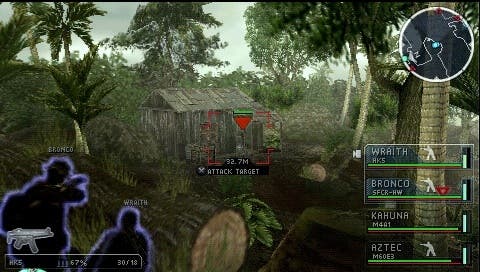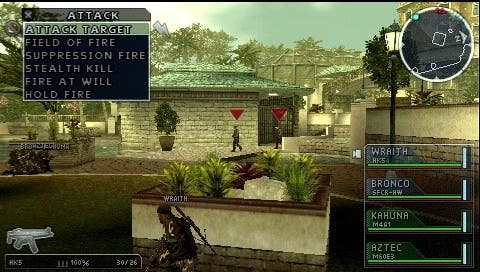SOCOM: US Navy SEALs Tactical Strike
SOCOM and get me.
I was a fan of the original SOCOM, not so much for the single-player game - although the voice recognition was cool - but for the online experience. I spent even more hours playing SOCOM II online, but by the time the third game was released, the novelty had worn off.
When the franchise first came to the PSP two years ago, I wasn't certain that Sony and Zipper would be able to pull it off. As it turned out, the PSP headset and online connection worked just fine, but the lack of a second analog stick ruined the experience for me (if I had a dollar every time I said that!). It wasn't an awful game by any means, but it definitely wasn't designed with the PSP's strengths (and weaknesses) in mind.
With the third and latest PSP SOCOM title, Tactical Strike, Sony has moved away from the PS2 ports and designed a game specifically for the handheld. The results are mixed. While it works fairly well, it deviates substantially from the prior games in the franchise.
The developers have come up with a novel way of compensating for the lack of a second analog stick - they've taken away control of the characters.
Not completely, of course, but instead of moving your Navy SEALs directly, you select actions from a menu and manoeuvre them around the landscape like an omnipresent Kasparov. It's more of a squad-based strategy game, like Ghost Recon: Advanced Warfighter...which is odd, as the PSP version of that game played more like SOCOM. Maybe the UMD hospital switched them at birth?
In the movement menu, the analog stick is used to direct a "skimmer" around the level. If you leave it in one place, the game displays ghosts of your team to indicate where the SEALs will end up. You can choose to move the entire fireteam at once, or move the two-man Alpha team or two-man Bravo team independently. Instead of executing movement commands instantly, you can also "pre-program" their moves and have them wait for your signal.
Movement is not the only thing you can control. You can also select different weapons and fire settings, telling the team when you want them to hold their fire, when they should fire at will, and what area they should concentrate their fire upon.

Graphically, the game looks about as good as any of the PS2 SOCOM titles, and the environments are quite large. There are nine main missions, which may not seem like a lot, but they can be played from two different insertion points which has an affect on strategy. In addition, the "instant action" mode gives you new objectives using these maps, and the online mutliplayer games (ad-hoc or infrastructure) use the maps for extraction, suppression, escort, and demolition missions. Although only four people can play the multiplayer games, there are still 16 SEALs involved as each person controls four men. Tactical Strike game supports clans, leaderboards, friends lists, and a social lobby as you would expect from an online game.
After each mission, you'll be graded on the overall mission, use of stealth, objectives and teamwork. Points awarded can be used to upgrade your characters in RPG fashion, improving general skills (carrying capacity, toughness, stealth) or weapon skills. Before each mission, you can visit the armory to create a custom loadout, although this is of questionable use since you often don't know you are going to need a specific weapon until after you've begun the mission.
For what it is worth, you can select teams from eight different nations: UK, Australia, France, Italy, Spain, Germany, South Korea, and the Netherlands. That's right - despite the game being named after "US" Navy SEALs, there aren't any Yanks to control. Each team speaks their native language, although otherwise they perform identically (which is a good thing, as otherwise your French SEALs would surrender to any enemy immediately).
If you're like me - an impatient person who skips to the end of the review to see the score first - you may be wondering what kept the game from receiving my unqualified recommendation.
For starters, the checkpoint system is somewhat flawed. It appears to be based upon the objectives you have achieved, but because the wide-open levels allow you to hit most of the objectives in any order, you may not reach a checkpoint when you really need one. For a handheld game, designed for quick play sessions, it is inexcusable to be forced to play 40 minutes or more without being able to save your progress.
On more than one level, I found myself holding my breath after achieving one difficult objective after the next, knowing that if I died before finding the checkpoint, I would have to do it all over again.

In movement mode, the camera remains above the SEAL team currently selected even as the skimmer moves forward into the environment. This means that you'll have to look at the tiny map in the corner of the screen to track the skimmer as it moves around walls and out of your sight. That's fine, except that it is hard to tell if the new location will be in the line of fire of an enemy. It would have been better if the camera could have followed the skimmer.
Speaking of enemies, they may be deadly accurate with their weapons, but they aren't too bright. Once you've been seen, you might expect that enemies elsewhere in the level will be alerted, but that isn't usually the case. You can also frequently kill enemies without raising the suspicion of those who should have been close enough to hear the shots.
Another complaint concerns the AI of your squad. They are smart enough to return fire when fired upon...usually...but heaven forbid that you accidentally leave one team out into the open while focused on moving the other team. They'll defend that open space to the death rather than attempting to find the nearest cover.
My main complaint is that, while it is fine for planning strategy, the game's methodical control scheme doesn't lend itself to the action. When under fire, the last thing you want to do is fiddle with the controls, trying to remember if you are supposed to tap or hold the button to get to the menu you want, then trying to carefully select the appropriate action from the menu with the overly-sensitive analog nub. And that's not even counting the fact that you are often facing the wrong direction or controlling the wrong team, which requires additional stick and menu movement to remedy before you can even join the fight. Your enemies, meanwhile, don't have the same burden.
Although the original SOCOM games also required you to give orders and use strategy, in a pinch you could run for cover, firing madly, and usually survive to tell about it. Here, your SEALs become sitting ducks while you are perusing menus. And while you can certainly reduce the likelihood of finding yourself in trouble through better advance planning, you can't avoid it altogether. No matter how careful you are, you are bound to come under fire from an enemy you didn't notice.

Which brings me to another complaint. SEALs can use health packs on themselves before their life bars are depleted, but otherwise they must rely on teammates to heal them. If the teammate doesn't reach them in time, they die. Fair enough, but there isn't a countdown clock to let you know how much time you have to reach a downed teammate. In addition, should a mission end when one SEAL dies or only when all SEALs die? The game can't seem to make up its mind. I once completed a mission by eliminating the final target with what appeared to be my sole surviving SEAL, but another mission ended when just one SEAL died - and well before I reached the end.
Finally - and this is a complaint that I have with the console SOCOM games and many other third-person shooters in general - the gameplay is too repetitive. With Tactical Strike, you must inch forward one team at a time, taking cover and eliminating enemies along the way to each objective. Although the objectives sound varied enough - locating someone, obtaining a document, sabotaging something, securing an area - in actuality, they just involve killing people and pressing the X button in the place where an icon appears.
If you get bored with the single-player missions, there's always the multiplayer option, but as with all online games, your enjoyment of multiplayer depends upon who you are playing with. Most games seem to devolve to a "kill everyone" deathmatch.
New developer Slant 6 has done a good job capturing the look and feel of the original franchise, but the new gameplay will disappoint those looking for a standard third-person shooter, and the game's flaws keep it from impressing more than it frustrates.
